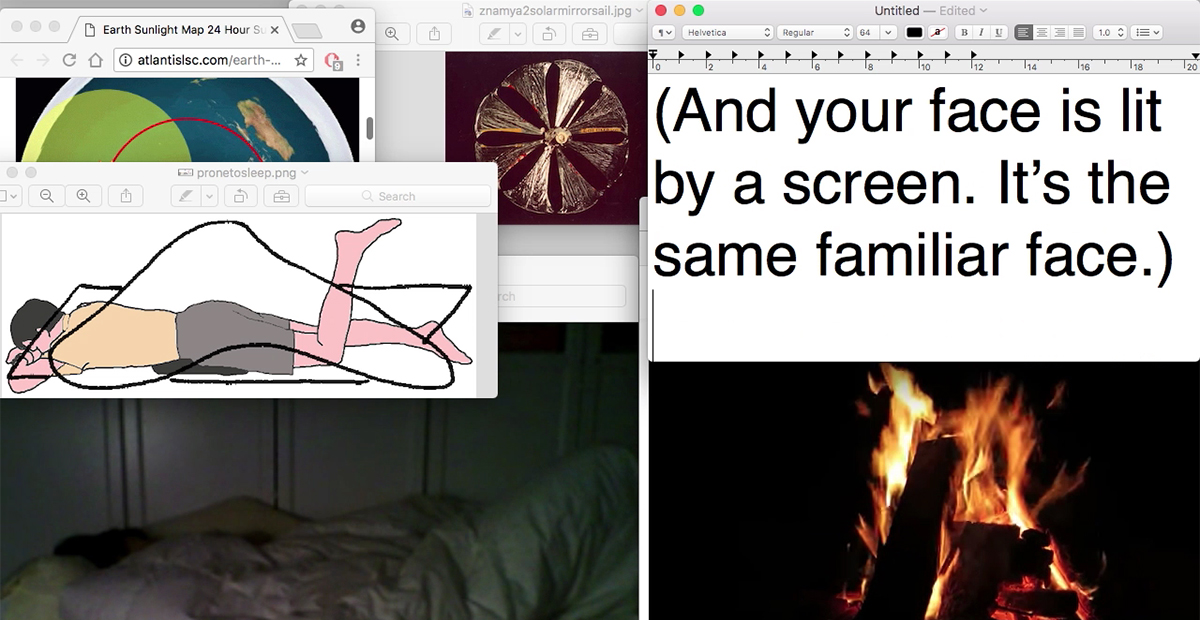
Video presentation + discussion
With Yoojin Lee (UK) + Ivetta Kang (CAN)
Saturday, February 26th, 1pm – 2pm (EST – Montreal), 6pm – 7 pm (UTC – London)
Online | https://us06web.zoom.us/j/87303182336?pwd=RXhNZm9tbE9USTRhd2E3Rm1nanZsZz09
Join us for a video screening of Yoojin Lee’s Artificial stars, followed by a discussion between Lee and artist Ivetta Kang, who will close the event with a small interactive exercise sourced from her Tenderhands project. This event is the second of an online series at Ada X exploring the place of embodied experience in our hyperconnected lives.
In Yoojin Lee’s video work Artificial stars, a collection of texts, images, and videos, some found and some made by the artist, become a reflection on the interdependencies between people and “technologies of light” (Lee’s description). Drawing on a text by Lee, As long as there is time to sleep, the video is part of a larger exploration of sleep and its stubborn, illogic persistance in an incessently illumated world.
Ivetta Kang’s Tenderhands is an ongoing writing project developing a series of poetic instructions that search for possibilities of “rebonding” between body and mind. Instruction #9, “To realize your unrealized hands,” is the conceptual framework of the series, which invites the reader to practice being present in a body, even if that presence is precarious.
The two artists, and their projects, will be in conversation to explore how the body is lost or found in the ambiguous terrains between virtual and material, private and public spaces.
Image courtesy of Yoojin Lee.
—
Text by Sandra Huber about the video work Artificial stars by Yoojin Lee:
“And your face is lit by a screen,” says a line of words moving across an open text edit window in London-based artist Yoojin Lee’s Artificial stars (2018). In this video piece, a busy yet somehow soothing laptop screen blends audio and visuals that pertain to a liminal space of sleeping and waking, both and neither, shared between bodies and technologies in a world that is never unlit. Experiencing Artificial stars is not unlike watching a polysomnography montage used in clinics to surveil the pathologies of sleep; only here, instead of readouts of the electricity of the body, we find GIFs and text boxes and Skype calls, the information of the daylight world, including a toolbar at bottom screen, a crackling ASMR fireplace, and a person sleeping under the covers. It is unclear whether the sleeper (while dreaming?) is writing the text that appears in the top left-hand corner of the screen or if they are actually the “you” being addressed in it.
A self-proclaimed night owl, Lee’s project is part of an ongoing engagement with sleep, which she sees not so much as a theme in her performance and multi-media installations, but rather as a way of knowing, one linked to slowness, de-composition, duration, and labour, to the infrathin between human and machine that occurs on material, psychic, and sensory levels — the borders between states of being and the artificial time frames in which we live them. Artificial stars is an articulation of the ways that light drenches even our darkest timelines — “the first manmade light,” the moving text tells us, “was made as long as 15,000 years ago — a flame of fire struck on shrubs,” an artificial star. The late hours are the “ungodly hours,” writes Lee in her short book, As long as there is time to sleep (2016). The montage that makes up Artificial Stars seems at times a reminder of the constant, slow purr of the celestial bodies above, of macrocosm and microcosm dancing in step. For me, one of the most intriguing images of the video is at the upper centre, portraying a Znaymya (banner) created in Russia in the 1990s as an artificial moon with a 65-foot-diameter wingspan propelled into space to extend daylight hours for heightened productivity. Here, it resembles an incandescent grapefruit or the garish sails of an aluminum ship. Who ventures into our sleeping worlds with us? What kinds of pixilated epistles are we composing behind our closed lids? What are our responsibilities and responses, as sleepers, to the world of the waking and the duties it holds?
Lee’s piece will be shown as part of an online event by Ada X on February 26th, 2022, which is an especially apt venue for this work: her screen montage folded into our own intimate screen montages. We are reminded in Lee’s video that the computer screen, which we are watching, also maintains its own rhythms — as the fireplace sizzles, as the sleeper stirs, a reminder pops up on the screen that the computer will “sleep soon unless plugged into a power outlet.” Regarding the clutch of images and sound that feature in Artificial stars, Lee points to the ways in which we are not necessarily solitary while we sleep, but rather always accompanied. The populations of our dreams and our co-sleepers are not only other bodies, but also our personal devices and lights, the projects and projections of our neon life worlds.
Yoojin Lee works across and in-between performance, sound, text, installation and video to embody ways of becoming and knowing through care, resistance and multiple temporalities. She sleeps in London.
Sandra Huber is a writer and PhD candidate in Interdisciplinary Humanities at Concordia University, where she focuses on the tools and techniques of contemporaray witchcraft.